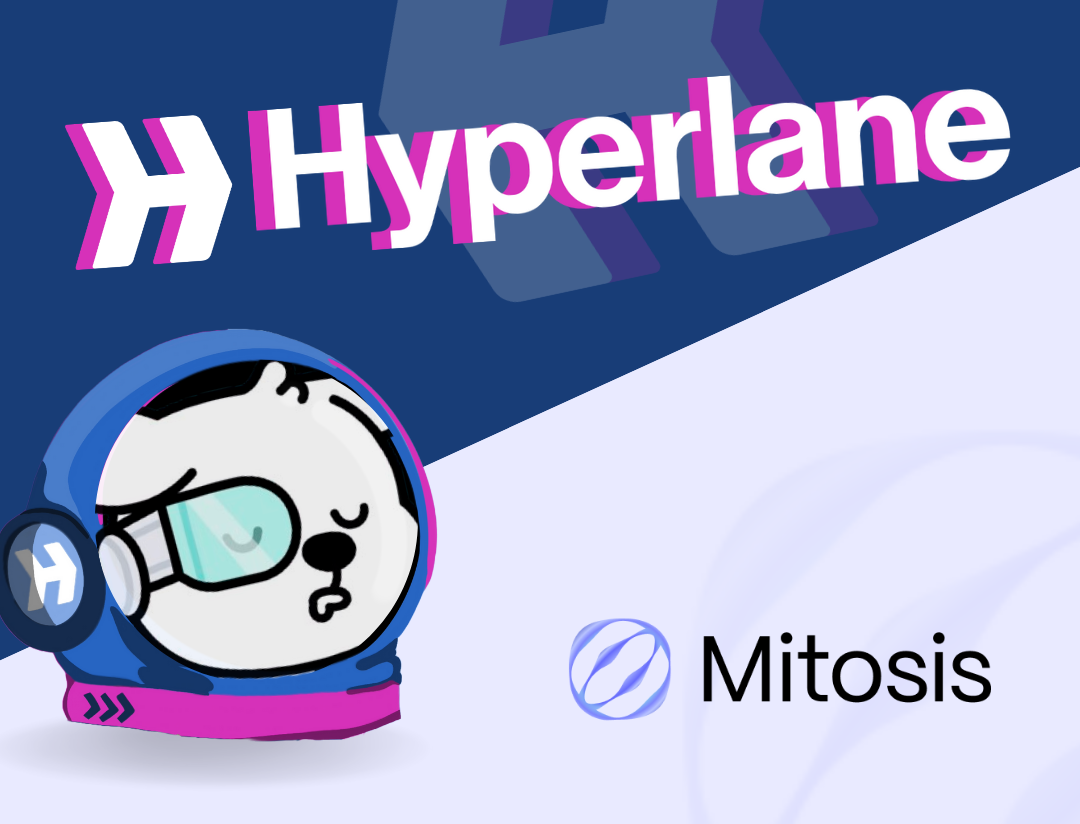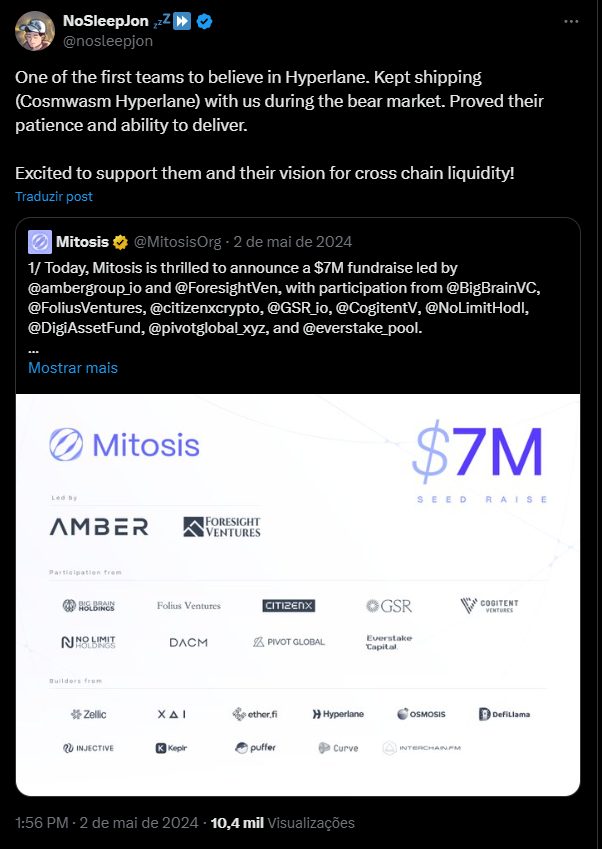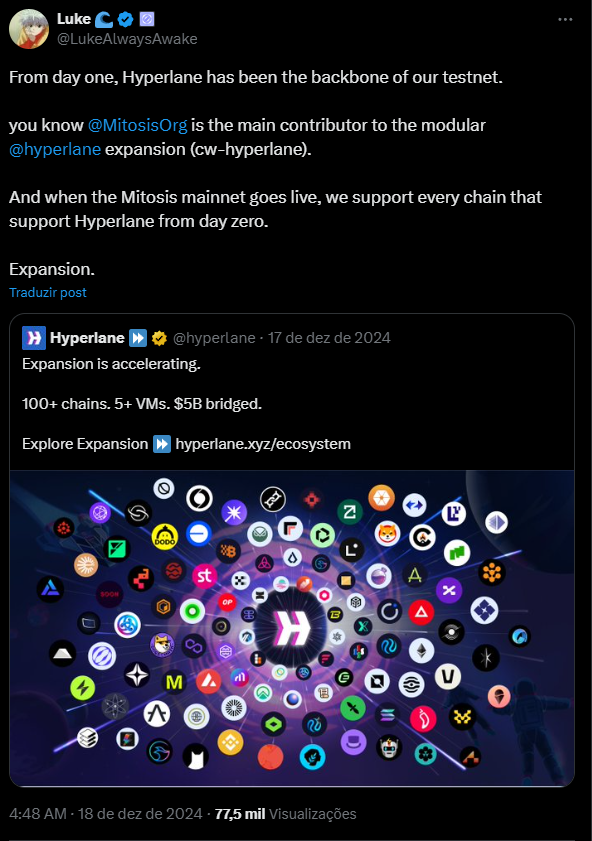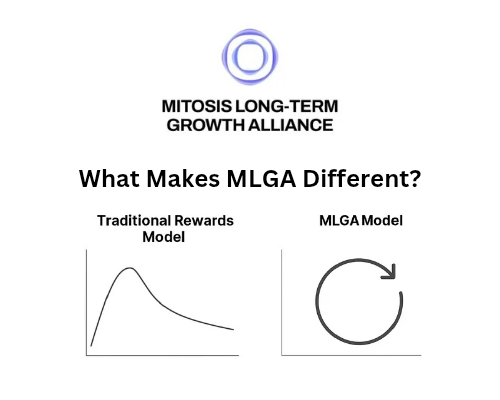Mitosis & Hyperlane: The Partnership Driving AltVM Expansion
The blockchain space is undergoing rapid evolution, and the emergence of alternative virtual machines (AltVMs) is at the heart of this transformation. Mitosis and Hyperlane, two pioneering entities, have established a partnership that could redefine how cross-chain liquidity and interoperability are achieved. This collaboration addresses critical issues in the blockchain ecosystem and sets the stage for the expansion of AltVMs into mainstream adoption.
The goal of this article is to explore the significance of this partnership, the challenges it addresses, and the impact it could have on the broader blockchain ecosystem. By combining the strengths of Hyperlane’s permissionless interoperability protocol and Mitosis’s modular liquidity layer, the two teams are tackling some of the most pressing issues facing developers and users in the multi-chain world.

Current Pains in the Crypto Market
The Dominance and Limitations of the EVM
The Ethereum Virtual Machine (EVM) has been a foundational innovation, enabling the deployment of smart contracts and decentralized applications (dApps). However, despite its critical role in blockchain development, the EVM is not without its flaws:
- Scalability Issues: The EVM’s sequential transaction processing severely limits throughput. As the number of users and applications grows, this bottleneck leads to network congestion and elevated gas fees.
- Security Vulnerabilities: Tokens in the EVM are represented as basic data types, such as integers, which lack built-in restrictions. This can lead to reentrancy attacks and other security exploits, creating risks for developers and users alike.
- Inefficiencies in Design: The EVM’s storage model imposes high computational and storage costs. Additionally, the 24KB bytecode limit constrains the complexity of smart contracts, forcing developers to spend more time optimizing code rather than innovating.
- Developer Onboarding Challenges: New developers often face a steep learning curve when transitioning to Solidity, Ethereum’s primary programming language. Despite its purpose-built nature, the language introduces barriers that can discourage newcomers.
- State Growth Management: As more smart contracts are deployed, the Ethereum network’s state—the data that nodes must store—continues to expand. This makes it harder for new nodes to synchronize and increases the hardware requirements for running a full node.
The Emergence of AltVMs
These challenges have sparked interest in alternative virtual machines (AltVMs), which aim to address the limitations of the EVM by offering specialized solutions for scalability, security, and efficiency. AltVMs represent a new frontier in blockchain technology, providing diverse execution environments tailored to specific use cases.
Why Do We Need AltVMs?
The Role of the EVM in Shaping Blockchain Development
The EVM has been instrumental in creating a standardized environment for smart contract execution. Its compatibility and extensive ecosystem have made it the go-to choice for many developers and projects. However, the very features that make the EVM reliable also limit its flexibility, as mentioned previously.
The Benefits of AltVMs
AltVMs offer several advantages that address these pain points:
- Improved Scalability: By introducing parallel transaction processing and optimized storage models, AltVMs can handle higher throughput.
- Enhanced Security: Many AltVMs implement resource-oriented programming models, which treat digital assets as unique entities, reducing the risk of duplication or loss.
- Greater Efficiency: Streamlined architectures reduce computational costs, making them ideal for applications requiring complex operations.
- Developer Flexibility: Support for widely-used programming languages like Rust and Move lowers barriers to entry, attracting more developers.
- Support for Specialized Use Cases: AltVMs can be tailored to specific applications, such as gaming or DeFi, enabling optimized performance.
Examples of AltVMs
The rise of AltVMs has introduced a range of innovative execution environments, each with unique features:
CosmWasm VM
Part of the Cosmos ecosystem, the CosmWasm VM enhances portability and simplifies smart contract development. Features like contract pinning improve performance by reducing gas costs and wait times.
- Who’s Building on CosmWasm? Mitosis leverages CosmWasm to serve as a liquidity hub for connected chains and rollups.
Solana Virtual Machine (SVM)
The SVM powers the Solana blockchain, offering high throughput and low latency. Its ability to process transactions in parallel has made it a preferred choice for high-performance applications.
- Emerging Use Cases: Projects like Eclipse and SonicSVM are leveraging the SVM to build L2s and gaming experiences.
MoveVM
Built for the Move programming language, the MoveVM emphasizes security and efficiency. Its resource-oriented programming model ensures that digital assets are treated as unique, non-duplicable resources.
- Notable Projects: Aptos and Sui are Move-based L1s that have gained significant traction.
Other AltVMs
- CairoVM (Starknet): Optimized for zk-rollups.
- FuelVM: A high-performance VM designed for modular blockchain architectures.
- Rootstock VM: The Rootstock Virtual Machine (RVM) is a forked version of the Ethereum Virtual Machine (EVM). It's the core of the Rootstock smart contract platform.
- Arbitrum Stylus: Stylus is built for the Arbitrum ecosystem, including Arbitrum One, Arbitrum Nova, and Arbitrum Orbit chains (layers 2).
- TonVM: Built for the TON blockchain, focusing on user-friendly interfaces.
The Big Challenge: Connecting All the VMs
The Fragmentation Problem
While AltVMs excel in specialized tasks, their distinct architectures create interoperability challenges. Without seamless communication, these ecosystems risk isolation, which limits access to liquidity, users, and applications.
The Complexity of Cross-VM Interoperability
Integrating AltVMs is a technically demanding process. Each VM has unique requirements, from programming languages to architectural nuances. For developers and interoperability protocols, this translates to significant time and resource investment.
The Importance of Interoperability
Cross-VM interoperability ensures that assets, applications, and users can move freely between ecosystems. This is critical for fostering innovation and maintaining a competitive blockchain landscape.
Hyperlane: The Future of Interchain Communication and Liquidity
Hyperlane is reshaping the blockchain ecosystem by enabling permissionless interoperability and seamless cross-chain communication. By addressing the key challenges of scalability, decentralization, and security, Hyperlane empowers developers and applications to thrive in a multichain world. Learn about the protocol's unique features and initiatives that position it as a pioneer in cross-chain connectivity.

Why Hyperlane?
Hyperlane’s distinctive approach to interchain messaging and interoperability offers several advantages that make it a standout choice for developers and projects:
- Comprehensive Interchain Messaging: The protocol supports messaging across all major EVM chains, with plans to expand into non-EVM environments. This broad compatibility ensures that developers can target diverse ecosystems.
- Economic Security by Default: By default, Hyperlane employs proof-of-stake mechanisms to secure its transactions. Developers can also explore multiple pre-configured security models tailored to their needs.
- Customizable Modular Security: Hyperlane’s modular architecture allows applications to define parameters for transactions, providing granular control over security models. This level of customization ensures that applications can optimize for both security and performance.
- Permissionless Usage: Hyperlane enables unrestricted deployment on any chain, ensuring a truly decentralized and permissionless experience for developers.
Hyperlane: Connecting AltVM Expansion
Hyperlane is designed to facilitate seamless communication and asset transfers across different blockchains. Unlike traditional interoperability solutions, Hyperlane operates without relying on centralized intermediaries or requiring permissions, granting developers full autonomy over their decentralized applications (dApps).

Its key features include:
- Permissionless Deployment: Developers can deploy Hyperlane on any blockchain environment — be it a Layer 1, rollup, or app-specific chain — without approvals or intermediaries. This design eliminates bottlenecks and enhances scalability.
- Modular Interchain Security Modules (ISM): Hyperlane provides customizable security configurations, allowing developers to adapt their security models to the unique needs of their applications.
- Interoperability API: By offering APIs, SDKs, and tooling, Hyperlane simplifies the process of building interchain dApps, turning it into a seamless experience for developers. It’s not just a bridge for asset transfers but an “information bridge” that supports diverse use cases, including asset transfer protocols built atop it.
AltVM Integrations
Hyperlane’s open framework supports a growing number of AltVMs:
- Cosmos: CosmWasm by Mitosis
- Solana: SVM by Abacus Works
- Move: MoveVM by Movement Labs
- Fuel: FuelVM by SimplyStaking
- Rootstock: Rootstock VM by Tacen Labs
- Starkware: Cairo by Astraly Labs (Pragma)
Modular Liquidity Expansion: Mitosis
One of Hyperlane’s most groundbreaking innovations is Mitosis, a modular liquidity expansion chain. Mitosis facilitates seamless liquidity transfers across chains, addressing a core challenge in decentralized finance (DeFi): fragmented liquidity. By enabling the movement of assets and value across ecosystems, Mitosis expands the utility and efficiency of liquidity pools.
About Mitosis
Mitosis is a modular liquidity protocol that addresses the challenges of fragmented liquidity in the multi-chain ecosystem. Built on Hyperlane, it provides a scalable and capital-efficient solution for connecting assets across chains.

How Mitosis Works?
Mitosis operates as an EVM-compatible, Cosmos-based blockchain with Hyperlane built-in as its core interoperability layer. The Mitosis chain acts as a liquidity hub for connected chains and rollups. Mitosis users can deposit assets from any supported chain and receive corresponding miAssets that they can use for DeFi on the Mitosis chain.
Mitosis L1 & miAssets
The Mitosis L1 chain provides the infrastructure that powers the protocol's liquidity collective. Secured by Ethereum through EigenLayer, it acts as the central hub where assets from various chains converge and EOL (External Onchain Liquidity) allocation decisions are executed. The chain enables a new asset class called miAssets, which represents a user’s share in EOL’s total liquidity and yield generation.
When users deposit assets into Mitosis Vaults, they receive 1:1 representative assets on the Mitosis chain. Users can then opt into EOL by converting these assets into miAssets, which represent yield-bearing tokens that accrue returns from EOL’s multi-chain allocations. For example, a user depositing ETH and opting into EOL receives miETH, granting them both governance rights over ETH allocation and claims to generate yields.
The Mitosis L1’s design enables sophisticated DeFi applications to be built atop miAssets. These applications can create new financial instruments that let users trade, provide liquidity, or take positions on yields generated across multiple chains simultaneously. This composability transforms passive liquidity into dynamic, yield-generating assets that reflect the collective performance of EOL strategies.
Key Features
- Capital Efficiency: Mitosis maximizes the usability of locked assets, turning them into yield-generating miAssets that power DeFi innovation.
- Scalability: With Hyperlane’s permissionless architecture, Mitosis can support over 100 chains from launch, ensuring rapid integration.
- User Experience: The intuitive design of the Mitosis protocol simplifies cross-chain asset management for users and developers alike.
Scaling with Permissionless Interoperability
Hyperlane’s permissionless design eliminates the need for chains to lobby for support. This allows Mitosis to scale rapidly and integrate with any chain or rollup, democratizing access to interoperability.
The Impact on New Chains
Traditional interoperability providers often prioritize established chains, leaving new chains at a disadvantage. Hyperlane’s model ensures that even nascent projects can achieve seamless integration, fostering innovation and growth.
The Value Mitosis Can Bring to Users as a Layer-1
As a Layer-1 blockchain, Mitosis offers a unique value proposition by acting as the central liquidity hub for interconnected ecosystems. Its infrastructure fosters:
- Capital Efficiency: Mitosis maximizes the usability of locked assets, turning them into yield-generating miAssets that power DeFi innovation.
- Yield Opportunities: miAssets provide users with access to yield-bearing instruments backed by diversified multi-chain liquidity strategies.
- DeFi Innovation: The modular design of Mitosis enables developers to build novel financial instruments and applications atop its ecosystem.
- Governance and Control: Users gain governance rights over liquidity allocations, ensuring a decentralized and user-centric approach.
- Cross-Chain Seamlessness: The integration of Hyperlane allows Mitosis to provide frictionless cross-chain transfers, enhancing user experience.
- Security and Reliability: By leveraging Ethereum’s security via EigenLayer, Mitosis ensures that assets and operations are protected at the highest level.

The Important Collaboration Between Mitosis and Hyperlane
The partnership between Mitosis and Hyperlane represents a milestone in blockchain interoperability. Mitosis was among the first to adopt Hyperlane, contributing to its CosmWasm implementation and demonstrating its technical expertise.

Mutual Benefits
- For Hyperlane: Mitosis’s integration showcases the protocol’s flexibility and scalability.
- For Mitosis: The collaboration enables Mitosis to support a wide range of chains from day one, enhancing its value proposition.

This partnership exemplifies how strategic collaboration can drive meaningful progress in the blockchain space.
Conclusion
The collaboration between Mitosis and Hyperlane is a blueprint for the future of blockchain technology. By addressing the challenges of liquidity fragmentation and interoperability, the two teams are enabling a more connected and efficient multi-chain ecosystem. As the adoption of AltVMs continues to grow, this partnership will play a pivotal role in shaping the next wave of blockchain innovation.
Join the Revolution
Welcome to the exciting world of Mitosis, where you can be part of a groundbreaking journey in decentralized finance! I would like to invite you to join the Mitosis Expedition campaign, a unique opportunity to engage with the future of cross-chain liquidity provision and asset management.
How to Get Involved:
- Deposit and Earn: Start by depositing your Liquid Restaking Tokens (LRTs) like weETH into the Mitosis protocol. By doing so, you'll receive miAssets, which not only represent your locked assets but also allow you to earn MITO Points. These points pave the way for eligibility in future governance token ($MITO) airdrops. Read this article for more details.
- Collect Badges: Engage in the campaign to collect various badges that not only signify your participation but also can increase your MITO Point earnings. Whether you're an early adopter, a long-term holder, or active in the community, there's a badge waiting for you. Read this article for more details.
- Explore the Ecosystem: Holding miAssets gives you a chance to explore and benefit from the miAsset DeFi ecosystem on Mitosis L1, where your assets can be utilized across various DeFi applications to maximize yield and liquidity across multiple chains (soon).
Start now!!!
Don't miss out on this chance to interact with Mitosis, earn rewards, and shape the future of DeFi. Join the Expedition campaign today and become an integral part of this evolving blockchain narrative!
For more details about Expedition Campaign, read the contents below:
• Website: https://app.mitosis.org/expedition/dashboard (my referral code: T19Z2D)
• Documentation of Expedition Campaign: https://docs.mitosis.org/docs/learn/governance/intro
• Mitosis Discord: https://discord.gg/mitosis
• Mitosis Linktree: https://link3.to/mitosisorg
• Galxe Quests: https://app.galxe.com/quest/Mitosis
Learn more and get started today!
Follow me on Twitter/X: febarce |DeFi

Comments ()